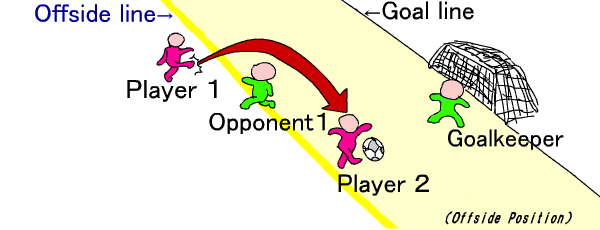|
|
 Not Offside Not Offside
[NOT OFFSIDE] 
|

|
On the opposing team's side of the field, Player 1 passes to Player 2,
who is in front of Opponent 1 (his position marks the offside line).
Note: The pass does not cross the offside line.
In the above diagram, it is the situation where there are at least two opponents beyond the player
that receives the pass.
『This is not offside』
|
|
 Offside Offside
[OFFSIDE] 
|

|
On the opposing team's side of the field, Player 1 passes to Player 2,
who is beyond Opponent 1 (his position marks the offside line).
Note: The pass crosses the offside line.
In the above diagram, it is the situation where there are less than two opponents (just the goalkeeper)
in the area beyond the player that receives the pass.
『This is offside』
|
 Why is this rule necessary? Why is this rule necessary?
 In the above diagram, what would happen if players could wait beyond the offside line to receive a pass? In the worst-case scenario, many players from both teams would wait in ambush at the opposing team's goal, which would handicap the goalkeeper and lower the quality of play. Also, it is said that since soccer was originally invented by the English as a sport for gentlemen, this type of ungentlemanly conduct was prohibited. In the above diagram, what would happen if players could wait beyond the offside line to receive a pass? In the worst-case scenario, many players from both teams would wait in ambush at the opposing team's goal, which would handicap the goalkeeper and lower the quality of play. Also, it is said that since soccer was originally invented by the English as a sport for gentlemen, this type of ungentlemanly conduct was prohibited.
|
The above is a basic summary of the offside rule. However, there are additional, more nuanced aspects of it as well.
For those who would like a more in-depth understanding of the offside rule, please refer to other site pages.
|
|





 Why is this rule necessary?
Why is this rule necessary? In the above diagram, what would happen if players could wait beyond the offside line to receive a pass? In the worst-case scenario, many players from both teams would wait in ambush at the opposing team's goal, which would handicap the goalkeeper and lower the quality of play. Also, it is said that since soccer was originally invented by the English as a sport for gentlemen, this type of ungentlemanly conduct was prohibited.
In the above diagram, what would happen if players could wait beyond the offside line to receive a pass? In the worst-case scenario, many players from both teams would wait in ambush at the opposing team's goal, which would handicap the goalkeeper and lower the quality of play. Also, it is said that since soccer was originally invented by the English as a sport for gentlemen, this type of ungentlemanly conduct was prohibited.
